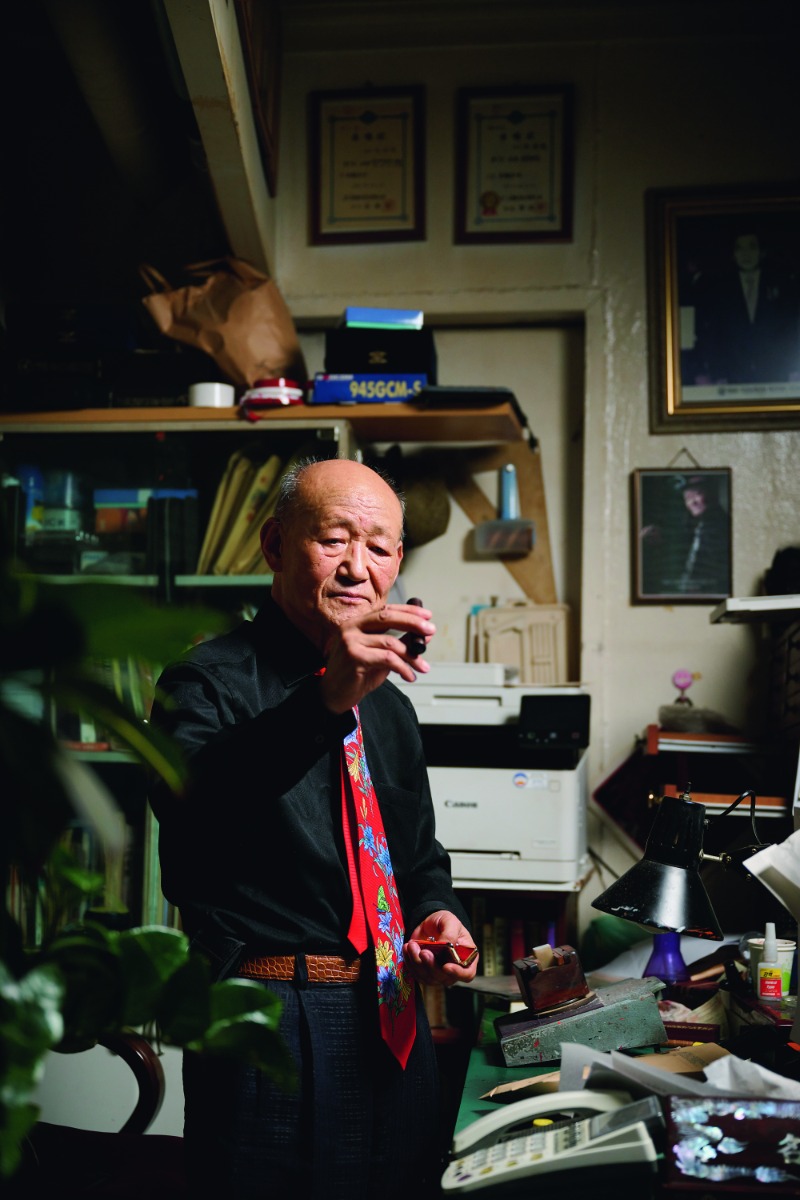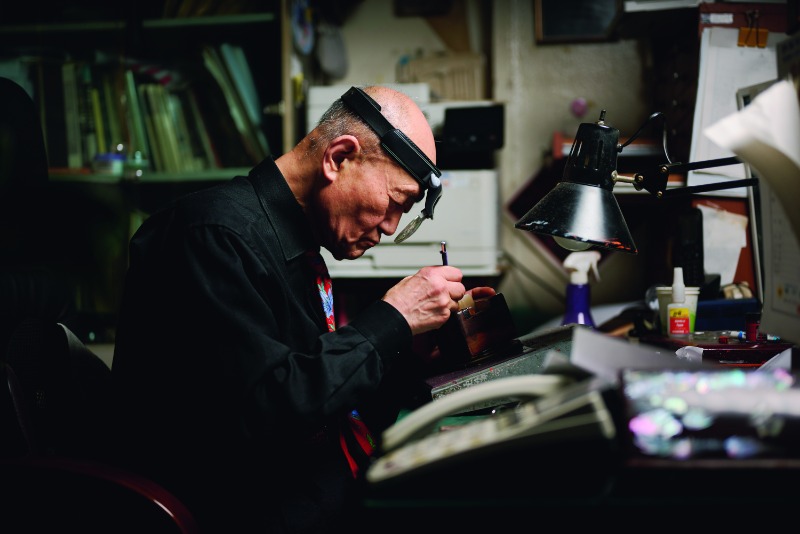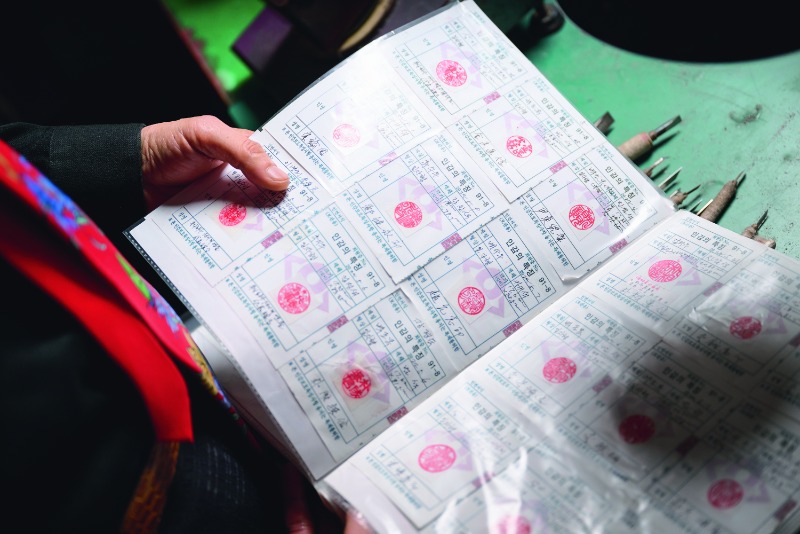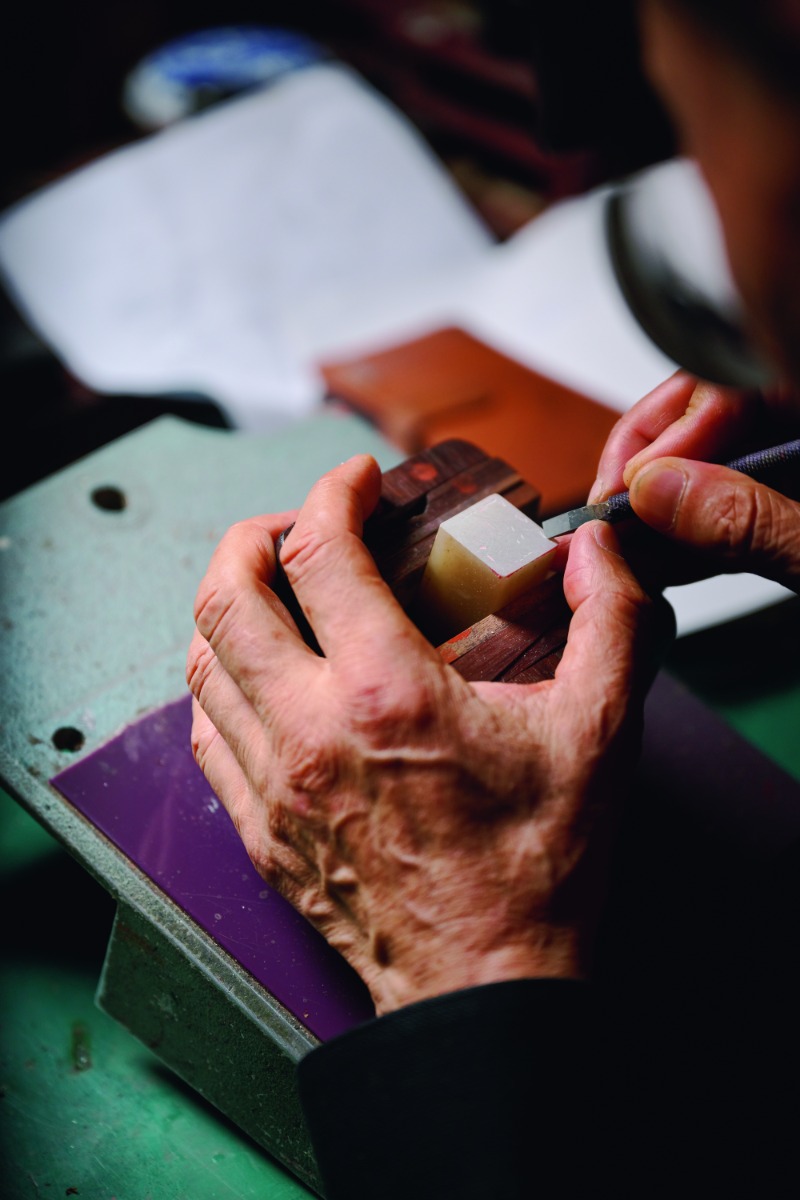Nearly everyone in Korea has a seal to stamp their name on contracts and s. Today, most seals are made quickly with computers and machines. At a tiny shop in Seoul, however, Park Ho-yeong hand-carves seals that are beyond unique – something he has been doing for the past seventy years.

Park Ho-young started making seals to survive the Korean War – and has never stopped. Nowadays, signatures are used on legal papers more and more, but Park remains undaunted, creating personal seals that are one of a kind.
Park Ho-Yeong’s workday begins with a one-hour subway ride to his snug shop on the third floor of an old building in central Seoul. The shop, called Bakindang (literally, “knowledgeable about seals”), has no signboard, so Park can hardly count on passing customer traffic. Still, he manages to stay in business with a small but loyal group of long-time regulars and referrals.
Surrounded with awards honoring his craftmanship, Park chooses from a variety of materials, from hardwoods to expensive jade from Gangwon Province, and selects the calligraphy styles and designs to satisfy his customers’ demands. He then carves the customer’s name on a surface that may be no larger than a small coin.
The custom-made seals, as Park matter-of-factly declares, are “one-of-a-kind.” The same deion could apply to him – there are few seal carvers left, not to mention other 84-year-olds who can handle a 10-hour workday every day of the year.
Beginning
The myth of Dangun, the founder of Gojoseon (Korea’s earliest iteration as a nation), mentions cheonbuin, or “heavenly symbols.” “Memorabilia of the Three Kingdoms” (Samguk yusa), compiled by the Buddhist monk Iryeon (1206-1289) during the Goryeo Dynasty, states, “Hwanin [Lord of Heaven] bestowed three heavenly symbols upon his son, Hwanung, and sent him down to rule everything under the sky and save the world of man.” Considering that the word “cheonbuin” includes the Chinese character “in” (印) for “seal,” many believe the heavenly symbols would have been tokens proving that Hwanung was truly the son of Hwanin, similar to the function that seals take on today.
Seals were once indispensable in every Korean person’s life. Without a personal seal, one could not finalize formal contracts, s or even a simple bank transaction. Even Korean War refugees leaving their homes to flee south brought their seals. Park, barely a teenager then, was among them. He left North Korea and ended up on Geoje, an island off the southern coast of Korea in early 1951, seven months after the war broke out. Wielding a hacksaw, he made the tools he needed to carve seals and used wood that he had cut himself. If a person did not have any money to buy a seal, he accepted payment in grain.
“I lived on the island for three years. At first, each person got three cups of rice a day, but then the rations got smaller and smaller until eventually, they dried up completely. There was nothing left to live on then, so everyone scattered again, back to the cities,” Park said.
Park moved to a shantytown in Busan. About six months later, a relative told him of a job opportunity: “I know someone who’s running a seal shop in Seoul’s Sindang-dong. What do you think about working there?” The sixteen-year-old Park packed his bags and moved to the capital.
“I worked in that shop for ten years. I learned from Master Kim Du-chil, who was a member of the Chusache Society,” Park says. (“Chusache” refers to the calligraphy style of Joseon literati painter and calligrapher Kim Jeong-hui, whose pen name was Chusa.) “He would write the characters during the day, and I would carve them at night. I also went to night school to get my high school degree. When things were busy, I would sleep only two hours a day. Back then, I got paid for each letter I carved. There were times when I carved 1,000 characters in just 24 hours.”
It was during this period that Park mastered the calligraphic styles and conventions of Chinese characters, including jwaseo (reversed , with characters right and left switched), jeonseo (seal ), yeseo (clerical ) and choseo (cursive ). He had already memorized the “Thousand Character Classic,” an introductory text widely used for learning Chinese characters, which was immeasurably helpful.
Transformations
Park was 26 years old when he started his own business; the beginning simply amounted to placing a desk in the corner of a printing shop in central Seoul. After moving from place to place for a few years, he eventually landed in his current location in a well-worn part of Seoul’s business district in the vicinity of Cheonggyecheon, a stream running through Seoul. This was 11 years ago, by which time Park’s cohort of seal carvers was already dwindling rapidly.
The advent of computer programs and carving machines in the 1990s meant that seals could be churned out quickly, thereby rendering hand-carving obsolete. Also, the use of signatures in lieu of seals in all kinds of dealings means that having a seal is no longer absolutely necessary.
“There are hardly any shops left anymore where they actually carve each seal by hand, one at a time,” Park says. “You just can’t make a good living that way, not to mention the difficulty of carving itself. No one wants to learn the trade anymore. You must know Chinese characters, and you have to learn calligraphy. If you don’t start when you’re young, it’s hard.”
Still, Park has no thoughts of stopping. Barring illness or unforeseen circumstances, he leaves home in the morning, 365 days a year, to open his eight-pyeong (26.4 square meters) shop. Park’s working hours are, technically, 10 a.m. to 8 p.m., but he often leaves his shop during the day. “As I get older, I have to go to the doctor more often. Around 3 p.m., I tend to go out for lunch,” he says.
The doctor’s visits are a side effect of Park’s vocation. According to him, seal carving has two requisites: focus and effort, both of which have exacted a toll over the decades. Some orders require Park to carve up to 24 characters on a surface smaller than a coin. Due to repeated eyestrain, he suffers from degeneration of the macula, a nerve tissue in the center of the retina, where most optic cells are located and images are formed. Macular degeneration can cause visual impairment and even complete blindness. In some cases, it can make letters or straight lines appear bent, twisted, or partially obscured.
“My left eye is fine. It’s the right one that’s going bad,” Park says. “It’s already been about 20 years. You can’t fix it with surgery, so I need to stop and rest a lot when I work. These days, I only make about one seal a day.”

When he is working, Park concentrates so hard that he does not even know when a customer enters his tiny shop. Although his eyesight has degenerated from long years of engraving letters onto a tiny surface, he laughingly says he might develop a worse physical problem if he quits.
One of a kind
“A seal is something you use your whole life, once you get one. And the seals I make are impossible to counterfeit,” Park says.
This is why consultation with the client is so vital. First, a material is chosen for the seal. Then Park determines how many Chinese characters and strokes will be needed to carve out the client’s name. Most Korean names (surname and given name) consist of three characters. In some cases, however, Park will add an extra character at the end to invite blessings and luck, in accordance with a school of thought which asserts that a person’s luck is affected by the total number of strokes in the characters of their name. After this calculation, he chooses the calligraphic style that best suits the client’s name and first writes it on the surface of the seal with a brush. Then comes the engraving work, which requires intense concentration.
“Even a tiny slip means starting over, from scratch. When you are really focused, time flies. But I do have to rest a lot these days, because of my eye,” Park says.
Park has an address book that holds the names, contact numbers and seal imprints (the ink mark left by the seal when stamped) of 4,700 clients. In 2001, Park’s semi-basement shop was damaged by the flooding of Cheonggyecheon, the stream in front of his shop. After that, although he was over 60 at the time, he purchased a computer and taught himself how to organize and store his customer records. Then he moved onto learning how to use Photoshop.

Records of seals made by Park show the uniqueness of each one. After losing his paperwork to flooding in 2001, he started counting his output again. His total was nearing 5,000 seals by the end of 2022.
Last Etches
When I ask whether he carries around a seal, Park reaches into his pocket and pulls out two seals. Their tiny cases were sewn for him by his wife when they were both young.
“My wife says I have done more than enough, and that I should rest. But I don’t want to. I don’t know anyone in my circle who’s still working. When you don’t have work, all you have left to do is eat and sleep. That makes your brain and your body atrophy. I can’t stop working, because I’m afraid that will happen to me, too.”
When I ask what he would say if he could make just one wish, he chuckles.
“A wish? No. I’m at the end of my life, what would I have to wish for? I just want to be healthy until the day I die.”
In Korea, it is often said that people leave their name behind when they die. A person’s name is believed to embody every action they have taken, every path they have walked, and every seed they have sown and harvested. The names carved by Park, and the names he has yet to carve, are no light matter. Even after many years have passed, his seals will remain as one-of-a-kind proof of life, witnesses to each individual existence.

These days a seal can be made in a few minutes using a computer program, but Park still engraves each letter by hand, wishing for his customers’ happiness. This is something a machine is not capable of doing.
Hwang Kyung-shin Writer
Han Jung-hyun Photographer